List of Capsicum cultivars
Capsicum germplasm
Capsicum species
There are perhaps fifty thousand Capsicum cultivars grown worldwide.[1] The USDA-ARS GRIN seed collection contains 6,200 Capsicum accessions alone, which include 4000 Capsicum annuum accessions. The other Capsicum species in the USDA germplasm repository include: C. chinense, C. baccatum, C. frutescens, C. pubescens, C. cardenasii, C. chacoense, C. flexuosum, C. eximium, C. rhomboideum, C. galapagoense, and C. tovarii. [2]
There are five major species of cultivated Capsicum, C. annuum, C. chinense, C. baccatum, C. frutescens, C. pubescens, and within those species are several "taxonomic varieties". Because of the ability of many of species to cross and generate inter-specific hybrids, albeit with low success, there are also what is referred to as "complexes" within the Capsicum genus of closely related and sexually compatible species.[3] This includes the Capsicum annuum complex, which consists of C. annuum, C. frutescens, and C. chinense.
Major species and their taxonomic varieties:[4]
- Capsicum annuum, which includes bell peppers, sweet/Italian peppers, serrano, cayenne, paprika and jalapeños
- Capsicum baccatum, which includes the South American varieties, such as ají amarillo, ají limon and criolla sella
- Capsicum chinense, which includes all of the Habaneros, Scotch Bonnets, Trinidad Scorpions, the Bhut Jolokia and the Carolina Reaper.
- Capsicum pubescens, which includes the Rocoto and Manzano pepper, and are distinctive plants in having violet flowers, black seeds and hairy dark green leaves and grows as a large multi-stemmed vine up to 5 meters long.[5]
- Capsicum frutescens, which includes the Brazilian Malagueta, the Tabascos and many of the peppers grown in India[5]
Types of cultivars
The species and varieties include many economically important cultivars with different shapes, colors, and flavors that are grown for different purposes, such as spices, vegetables, and herbal medicines. Some confusion has resulted from the legal term "plant variety", which is used interchangeably with "cultivar" (not with "taxonomic variety"). The terminology around a cultivar also includes terms such as heirloom, open-pollinated, self-pollinated, and hybrid.[8]
Heirloom varieties are typically those that have been selected and grown historically with seed saved every year, and are still maintained today in similar fashion, such as the blocky-type California Wonder. Open-pollinated varieties are those that are maintained without strict barriers to prevent out-crossing and then seed is collected at and stored from each harvest such as the lamuyo-type Marconi Yellow. While open-pollinated varieties are typically true-to-type, there may be occasional out-crossing to other Capsicum varieties that may introduce some heterogeneity. Self-pollinated varieties are similar to open-pollinated varieties in that they are true-to-type and seed is collected at and stored from each harvest, but measures are taken to minimize out-crossing. This may involve placing a barrier such as a mesh bag or cage over the plant to prevent pollinators from reaching flowers, ensuring that the plant has "selfed". This is how much seed intended for home-garden use is produce, like the cultivar Early Jalapeno. These three types of cultivar seed production are all similar in that only one parent is used and the seed are produced generally through selfing.
Hybrid varieties take advantage of a phenomena called heterosis or hybrid vigor, which occurs in pepper. To generate a hybrid variety, two self-pollinated varieties are intentionally crossed, and all seed from this cross are collected. The new hybrid variety typically is more vigorous than either of the two parents contributing to traits such as higher yield.[8] Hybrid seed if saved will not produce a homogeneous set of plants the next generation, meaning that the two parents will need to be crossed again to generate more hybrid seed. This method is used to produce hybrid Capsicum cultivars such as the blocky-types Double-Up and Orange Blaze. Much of the commercial pepper production uses hybrid varieties for their improved traits.
Due to the large and changing number of cultivars, and the variation of cultivar namings in different regions, this list only gives a few examples of the estimated 50,000 pepper varieties that exist.
Capsicum annuum
Capsicum annuum, native from southern North America through Central America to South America, has been cultivated worldwide for over 400 years.[9] Its forms are varied, from large to small, sweet to sour, and very hot/pungent to bland. Despite being a single species, C. annuum has many forms, with a variety of names, even in the same language. Official names aside, in American English, any variety lacking heat is colloquially known as a sweet pepper, and those sweet peppers that have a blocky-shape are referred to as bell peppers. A variety that produces capsaicin is colloquially known as a hot pepper or chili pepper. In British English, the sweet varieties are called "peppers"[10] and the hot varieties "chillies",[11] whereas in Australian English, the name "capsicum" is commonly used for bell peppers exclusively and "chilli" is often used to encompass the hotter varieties.
The plant is a tender perennial subshrub, with a densely branched stem. The plant reaches 0.5–1.5 m (20–60 in). Single white flowers develop into the fruit, which is typically green when unripe, but may lack chlorophyll causing a white color, changing usually to red, although some varieties may ripen to yellow, orange, peach, brown, or purple . The species are grown in temperate climates as an annual, but they are especially productive in warm and dry climates.[12]
Capsicum types
There are several different general types typically based on shape, intended use and pungency level. Some general types include:
- Anaheim
- Ancho/ Poblano
- These are the same type. They differ in whether the fruit is eaten fresh or dried.
- Blocky or Bell
- Cascabel
- Cayenne
- Chiltepins or Small Hots
- 'Fresno Chili'
- Jalapeno
- Ornamental
- Pasilla
- Pimiento
- Serrano
- Waxy
| Image | Name | Type | Origin | Heat | Pod Size | Description | |
|---|---|---|---|---|---|---|---|
| Aci Sivri[13] | Turkey | 15–20 cm (5.9–7.9 in) | |||||
| Afghan Short | Afghanistan | 5,000–30,000 SR | 5–8 cm (2.0–3.1 in) | Grown in Afghanistan. | |||
| Albino Bullnose[13] | Sweet | ||||||
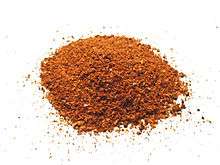 |
Aleppo | Syria and Turkey | 15,000 SR | Grown in Syria and Turkey and used, in coarsely ground, dried form, as a spice that is also called aleppo pepper | |||
| Alma Paprika[13] | Hungary | 10,000 SR | A Hungarian pepper often pickled or dried and ground to make spicy paprika | ||||
 |
Anaheim[13] | Anaheim | United States | 500–2,500 SR | 15 cm (5.9 in) | A mild variety of New Mexico chile. It was later brought to California from New Mexico by Emilio Ortega in the 1900s. Often it is used for chile relleno. When mature, it takes on a red color and is referred to as a colorado. | |
| Ancient Sweet | 0 SR | 250–300 mm (10–12 in) long by 38–51 mm (1 1⁄2–2 in) wide | Medium tall plant produce heavy loads of extra sweet red in color fruits, plant have white flowers & thin flesh. This variety sets the record for the sweetest pepper with 1.5 times the sweetness of a ripe red bell pepper. | ||||
 |
Banana | Waxy | 0–500 SR | 15 cm (5.9 in) | Often it is pickled and used as an ingredient in sandwiches; its piquancy is not very hot. Its shape and color resemble a banana. | ||
| Barkers Hot | |||||||
 |
Beaver Dam[13] | United States | |||||
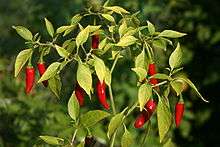 |
Bird's Eye | Small hot | Southeast Asia | 50,000–100,000[14] SR | 4 cm (1.6 in) | A Southeast Asian cultivar known by many local names, but generally it is called Thai chili in the United States. It has thin fruit with a pointed tip. | |
| Black Cuban[15] | |||||||
 |
Black Hungarian | Shape of a jalapeño. Deep, dark purple in color. | |||||
| Black Pearl | Ornamental | United States | Ornamental plant. Winner of the All-America Selections (AAS) Flower Award in 2006.[16] Dark leaves with berry-shaped fruit. | ||||
| Black Prince | Ornamental | Ornamental. | |||||
| Brigadier | Blocky | Europe | 0 SR | 12.5 cm (4.9 in) | Large red blocky hybrid variety with good texture that has disease resistance to Bacterial Leaf Spot and Potato Virus Y. It is adapted to cooler, wetter climates. | ||
| Bulgarian Carrot | Bulgaria | 12,000 SR | 76 mm (3 in) | ||||
| Bulgarian Ratund | 0 SR | 64 mm (2.5 in) | |||||
| Bullnose | Long Sweet | United States | 0 SR | ||||
| California Wonder[15] | Blocky | United States | 0 SR | ||||
 |
Canary Bell | Blocky | United States | 0 SR | |||
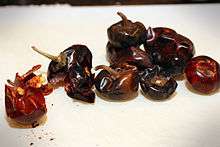 |
Cascabel | Mexico | 3,000 SR | 2.5 cm (0.98 in) | The small, round fruit are usually dried, and have a distinct, nutty flavor. The name, Spanish for "rattle" or "jingle bell", derives from the rattling noise made by the seeds inside the dried pod. | ||
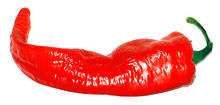 |
Cayenne (Red)[15] | Cayenne | French Guiana | 30,000–50,000 SR | 12.5 cm (4.9 in) | This long, thin fruit was transported by the Portuguese to China and India, where it is used widely. Often it is dried and ground into powder. | |
| Charleston Belle | Bell | United States | The first nematode-resistant bell pepper. Created in Charleston, South Carolina by the USDA.[17] | ||||
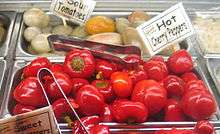 |
Cherry | Pimiento | 3,500 SR | 2.5 cm (0.98 in) | Named for the fruit it resembles, this cultivar's fruit is small, red, and round. It is typically used fresh, or pickled and jarred, and is often used to stuff green olives. It is also called pimento. | ||
| Chervena Chuska | Bulgarian | 0 SR | 150 mm (6 in) | Also spelled "Chushka". Very sweet. | |||
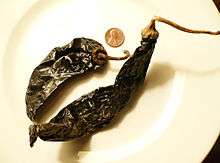 |
Chilaca | Pasilla | 1,000–2,000 SR | 15 cm (5.9 in) | Popular in Mexican cuisine, it is almost always encountered dried; in this state, it is referred to as a pasilla. The pasilla has a dark brown color and a smoky flavor. | ||
| Chile Rama | Nicaragua | ||||||
 |
Chiltepin[15] | Chiltepin | 50,000–100,000 SR | 0.5 cm (0.20 in) | This small, hot fruit is often eaten by birds. The plant is thought to be the ancestor of the cultivated C. annuum peppers. Evidence indicates it has been consumed by humans as far back as 7,500 BC.[18] | ||
| Chimayo | United States | 4,000–6,000 SR | |||||
| Chinese Five-Color | 5,000–30,000 SR | 3.5 cm (1.4 in) | The fruit starts out purple, then changes to white, yellow, orange, and red. Similar to Bolivian rainbow pepper and 'NuMex Twilight' pepper, it is also called Chinese multicolor pepper. | ||||
| Chiltoma Grande de Ometepe | Nicaragua | ||||||
| Chocolate Beauty | Blocky | 0 SR | |||||
| Ciliegia Piccante | Italy | ||||||
| Coban Red Pimiento | Pimiento | Guatemala | |||||
| Corne De Chevre | Italian | Spain | |||||
| Corno di Toro Giallo | Italian | Italy | 0 SR | ||||
| Corno di Toro Rosso | Italian | Italy | |||||
| Costeno Amarillo[15] | |||||||
| Cowhorn | Italian | 0–500 SR | 200 mm (8 in) | Plant produces good yields of 200 mm (8 in) long sweet pepper. Pepper are very sweet and have excellent flavor! Peppers turn from green to red when mature. One of the largest non-bell stuffing peppers around | |||
| Criolla De Cocina Pepper | Nicaragua | ||||||
 |
Cubanelle | 1–1,000 SR | 130 mm (5 in) | Medium in thickness, the tapered fruit is green when unripe, but turns red when mature. Often it is fried in Italian cooking. | |||
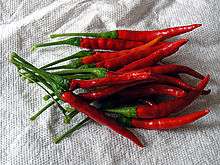 |
De árbol[15] | Mexico | 15,000–30,000 SR | 8 cm (3.1 in) | This slender-fruited cultivar is grown primarily in Mexico, its name is Spanish for "from a tree". | ||
| Doux D'Espagne | Lamuyo | 0 SR | Also known as a Spanish Mammoth Pepper. | ||||
 |
Early Jalapeño[15] | Jalapeno | United States | 1,000–3,000 SR | 6 cm (2.4 in) | This variety is one of the most popular home-gardening varieties. It matures faster than many jalapenos, and although it may have small jalapenos, it produces high yields. | |
| Elephant Trunk | 5,000–10,000 SR | 150 to 250 mm (6 to 10 in) long by 25 mm (1 in) wide | Plant produces good yields of 6" to 10" long by 1" wide tapered and wrinkled hot peppers. Pepper resemble an elephant's trunk. They are mild and turn from green to red when mature. Plant has green stems, green leaves, and white flowers. Can be used green or red. A variety from India. Plant Height: 50" tall | ||||
| Emerald Giant | 0 SR | ||||||
| Espanola Improved[19] | United States | 2,000–4,000 SR | |||||
| Estaceno | United States | 250 mm (10 in) | New Mexican-style chili pepper. | ||||
| Ethiopian Brown | |||||||
| Etuida | Poland | ||||||
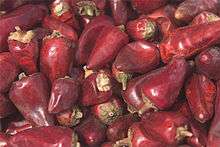 |
Facing Heaven | Pimiento | China | ||||
| Filius Blue | Ornamental | Ornamental, multi-colored pepper plant. | |||||
| Fish Pepper | 5,000–30,000 SR | ||||||
| Floral Gem[15] | |||||||
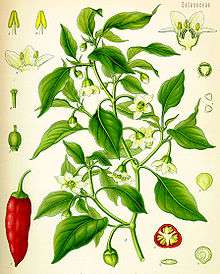 |
Fresno | Fresno | United States | 2,500–10,000 SR | 9 cm (3.5 in) | Similar to the jalapeño, but with thinner walls, it is generally used ripe, and has a higher vitamin content. Frequently it is used in ceviche, and is one of the most frequently used chilis in salsa. | |
| Friariello di Napoli | Italy | 0 SR | |||||
| Fushimi | Japan | 0 SR | 150 mm (6 in) | ||||
| Gambo | |||||||
| Georgescu Chocolate | Romania | 0 SR | 130 mm (5 in) | ||||
| Goat Horn | Lamuyo | ||||||
| Golden Cal Wonder | Blocky | 0 SR | |||||
 |
Golden Cayenne | Cayenne | 100–150 mm (4–6 in) | ||||
| Golden Marconi | Italy | 0 SR | 180 mm (7 in) | ||||
| Golden Treasures | Italian | 0 SR | |||||
 |
Guntur Sannam | 35,000–40,000 SR | It is well known as a commercial crop used as a condiment, culinary supplement, or vegetable. | ||||
| Hinkelhatz | United States | 25–51 mm (1–2 in) | Also known as Hinkel Hatz or Hinklehatz. | ||||
| Hole Mole | United States | 700 SR | 180–230 mm (7–9 in) | 2007 All-America Selection. | |||
| Hontaka[15] | Asian heirloom. | ||||||
| Horizon Bell | Blocky | 0 SR | Medium green to orange-yellow at maturity. | ||||
 |
Hungarian Wax | Waxy | 2,500–8,000 SR | This wide, medium-hot variety is used in Hungarian cuisine, frequently pickled. Also it is commonly dried, ground, and presented as "paprika". | |||
 |
Italian Sweet | Long Sweet | Italy | Used in Spanish cuisine | |||
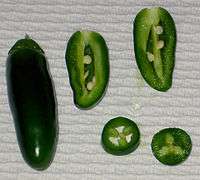 |
Jalapeño | Jalapeno | Mexico | 2,500–8,000 SR | 9 cm (3.5 in) | Very popular, especially in the United States, it is often pickled or canned. A smoke-dried ripe jalapeño is referred to as a chipotle. | |
| Japones | 15,000–35,000 SR | Usually found dried. Flatter and thicker than arbol chilis. | |||||
| Jigsaw[15] | Ornamental. | ||||||
| Jimmy Nardello Italian | Italy | 0 SR | |||||
| Joe's Long Cayenne | Cayenne | 200–250 mm (8–10 in) | |||||
| Jupiter[15] | Blocky | 0 SR | |||||
| Jwala | India | 20,000–30,000 SR | 100 mm (4 in) | Also known as Pusa Jwala. | |||
| King of the North | Blocky | 0 SR | 25–51 mm (1–2 in) | Works well for short-season growers. Productive in northern climates. | |||
| Korean Dark Green | Small Hot | 76–102 mm (3–4 in) | |||||
| Krimzon Lee | 200 mm (8 in) | ||||||
| Large Red Antigua | Guatemala | 0 SR | Also known as the Large Sweet Antigua. | ||||
| Leutschauer Paprika | Hungary | ||||||
| Lilac Bell | 0 SR | ||||||
| Lipstick | Lamuyo | 0 SR | 100 mm (4 in) | ||||
| Lumbre | United States | 9,000–10,000 SR | 130 mm (5 in) | ||||
| Macho | Mexico | ||||||
| Mammi Huber's Stuffing | United States | 0 SR | |||||
| Marta Polka | Poland | 0 SR | |||||
| Maule's Red Hot | United States | 250–300 mm (10–12 in) | |||||
 |
Medusa | Ornamental | It is a sweet, ornamental chili pepper which grows upright and has brightly colored fruit. | ||||
| Melrose | Lamuyo | Italy | 0 SR | 100 mm (4 in) | |||
| Midnight Dreams Bell | Blocky | 0 SR | Black ebony-colored bell pepper. | ||||
 |
Miniature Bell | Blocky | United States | 0 SR | |||
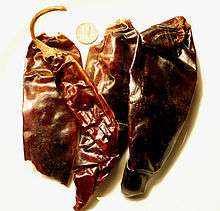 |
Mirasol | Mexico | 2,000–5,000[20] SR | Its dried form is called guajillo,[15][21] and is used to make a red sauce used for tamales. | |||
| Mora | A small chili about 130 mm (5 in) long and 51 mm (2 in) wide, and purple, it is always used dry. It is extremely spicy, and is used as a substitute for chipotle when more powerful spice is needed. | ||||||
| Morita | Morita: A variety of the chipotle style of chiles (dried smoked jalapeños).
The morita is typically made from a certain type of Jalapeños fully ripened purplish color (hence the name "mora =berry") and only dried just when they are leathery but still shiny. Also called "Chipotle Colorado," "Mora Chile," but usually smaller about 3–4 cm (1.2–1.6 in) after drying. Usually spicier than the typical chipotle. [] | ||||||
| |
Mulato[15] | Poblano | Mexico | 2,500–3,000 SR | 10 cm (3.9 in) | Grown in Mexico, the mulato is a mild to medium chili pepper,
closely related to the poblano (ancho), and usually sold dried. | |
| Moshi | Tanzania | 51 mm (2 in) | |||||
| New Mexico No. 6[19] | United States | ||||||
| New Mexico 6-4[19] | United States | ||||||
| New Mexico No. 9[19] | United States | ||||||
| Nippon Taka | Japan | ||||||
| NuMex April Fool's Day[15] | United States | Ornamental chili plant with long thin pods, fruits mature from purple to red. | |||||
| NuMex Bailey Piquin[19] | Ornamental | United States | 97,000 SR | ||||
| NuMex Barker's X-Hot | United States | 9,000–15,000 SR | 130 mm (5 in) | ||||
 |
NuMex Big Jim[19] | United States | 2,000–4,000 SR | ||||
| NuMex Centennial[19] | Ornamental | United States | Ornamental chili plant with upright bullet shaped pods. Colour transitions from purple to yellow, orange and finally red. | ||||
| NuMex Chinese New Year[15] | Ornamental | United States | Ornamental chili plant with bullet shaped fruits that grow in clusters. Fruits mature from light green to red. | ||||
| NuMex Christmas[19] | Ornamental | United States | Ornamental chili plant with upright bullet shaped pods. Colour transitions from green to bright red. | ||||
| NuMex Cinco de Mayo[15] | Ornamental | United States | Ornamental chili plant with long thin pods, fruits mature from yellow to red. | ||||
| NuMex Conquistador[19] | United States | ||||||
| NuMex Earth Day | United States | ||||||
| NuMex Easter[15] | Ornamental | United States | Ornamental chili plant with upright bullet shaped pods, fruits turning purple - white - red while ripening. | ||||
| NuMex Eclipse[19] | United States | ||||||
| NuMex Garnet[19] | Anaheim | United States | 0 SR | ||||
| |
NuMex Halloween[19] | Ornamental | United States | 20,000–30,000 SR | 2–3 cm (0.79–1.18 in) | Ornamental chili plant with small upright bullet shaped black pods, fruits turning orange while ripening. | |
| NuMex Heritage 6-4[19] | United States | 3,000–5,000 SR | |||||
| NuMex Heritage Big Jim[19] | United States | ||||||
| NuMex Jalmundo[15] | Jalapeno | United States | 17,000 SR | 130 mm (5 in) | |||
| NuMex Joe E. Parker[19] | Anaheim | United States | 2,000–4,000 SR | ||||
| NuMex Las Cruces Cayenne | Cayenne | United States | A well yield cayenne cultivar with virus resistance to Beet curly top virus. | ||||
| NuMex Memorial Day[19] | Ornamental | United States | Ornamental chili plant with small upright bullet shaped pods, colour transitions from pale ivory to yellow. | ||||
| NuMex Mirasol[19] | United States | Used for cooking in a ground powder and as an ornamental on wreaths. | |||||
| NuMex Nematador[19] | United States | ||||||
| NuMex Piñata[19] | Ornamental | United States | |||||
| NuMex Primavera[19] | United States | ||||||
| NuMex R. Naky[19] | Anaheim | United States | 260 SR | A great mild paprika cultivar. | |||
| NuMex Sandia Hot | United States | 7,000–9,000 SR | 180 mm (7 in) | ||||
| Picture of NuMex Sandia Select [22] | NuMex Sandia Select[19] | United States | |||||
| NuMex St. Patrick's Day[19] | Ornamental | United States | Ornamental chili plant with upright bullet shaped pods. Colour transitions from green to orange. | ||||
| NuMex Sunburst[19] | Ornamental | United States | |||||
| NuMex Sunflare[19] | Ornamental | United States | |||||
| NuMex Sunglo[19] | Ornamental | United States | |||||
| NuMex Sunrise[19] | Ornamental | United States | |||||
| NuMex Sunset[19] | United States | ||||||
| NuMex Sweet[19] | United States | 0 SR | |||||
| NuMex Thanksgiving[19] | Ornamental | United States | Ornamental chili plant with upright bullet shaped pods. Colour transitions from pale ivory to orange. | ||||
 |
NuMex Twilight[19] | Ornamental | United States | 30,000–50,000 SR | Ornamental chili plant with upright bullet shaped pods. Colour transitions from purple to yellow, orange and finally red. | ||
| NuMex Valentine's Day[19] | Ornamental | United States | Ornamental chili plant with upright bullet shaped pods. Colour transitions from pale ivory to red. | ||||
| NuMex Vaquero[19] | Jalapeno | United States | |||||
| NuMex Veteran's Day | United States | Ornamental chili plant with upright bullet shaped fruits that grow in clusters. Fruits turn from dark violet to dark orange while ripening. | |||||
| Oda | 0 SR | ||||||
| Onza[15] | Pasilla | Mexico | Usually dried for sauces and soups. | ||||
| Orange Bell Pepper | Blocky | 0 SR | |||||
| Ostra-Cyklon | Poland | 110 mm (4.5 in) | |||||
| Ozark Giant | 0 SR | ||||||
| Padrón | Pasilla | Spain | 0 SR | 25–38 mm (1–1.5 in) | An heirloom variety usually dried and used as spcices in traditional Spanish dishes. | ||
| Paradicsom Alaku Sarga Szentes | Hungary | Pumpkin-shaped fruit. | |||||
 |
Pasilla Bajio | Pasilla | Mexico | 1,000–2,000 SR | |||
| Peperone di Cuneo | Italy | 0 SR | |||||
| Peruvian Purple | Peru | 25 mm (1 in) | |||||
| |
Peter Pepper | Ornamental | United States and Mexico | 5,000–30,000 SR | 8–10 cm (3.1–3.9 in) | Rare, heirloom-type hot pepper cultivated for its unique shape. | |
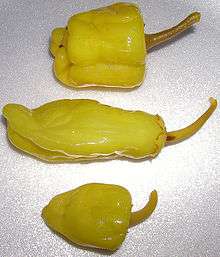 |
Pepperoncini (peperoncini) | Waxy | Italy | 100–500 SR | 8 cm (3.1 in) | Sweet-tasting and mild, used extensively in Italian and Greek cuisine, very frequently pickled. | |
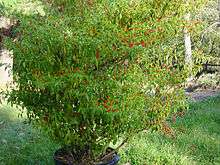 |
Pequin | Small Hot | United States and Mexico | 100,000–140,000 SR | Also spelled piquín | ||
 |
Piment d'Espelette[15] | Pimiento | Basque Country (French part) | 1,500 - 2,500 SR | Fresh fruits, plants and seeds are known as "Gorria", dried fruits are called "Piment d'Espelette". "Gorria" is the Basque word for "red".
Grown in Espelette since ca. 1650. | ||
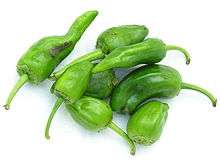 |
Pimiento De Padrón | Pimiento | Spain | ||||
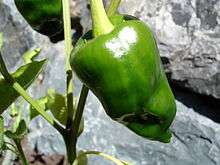 |
Poblano[15] | Poblano | Mexico | 1,000–2,000 SR | 13 cm (5.1 in) | The large, heart-shaped, dark green fruit is extremely popular in Mexico, often to make chile relleno. When dried, it is referred to as an ancho or mulato. | |
| Polostra-Rokita Pepper | 30,000–50,000 SR | ||||||
 |
Prik Kee Nu | Small Hot | Thailand | 50,000–100,000 SR | 3 cm (1.2 in) | One of many cultivars called Thai pepper, it has very short fruit, and is very hot.[6] Thai: พริกขี้หนู, rtgs: phrik khi nu, IPA: [pʰrík kʰîː nǔː], literal: Mouse/rat dropping chili. | |
| Purple Flash | Ornamental | Ornamental | |||||
| Purple Jalapeño | Jalapeno | Jalapeño-like pepper that turns purple before ripening and becoming red. | |||||
| Puya | Mexico | 5,000 SR[23] | Capsicum annuum L.,[24] hot, medium-size, green to red, and tapered[25] Also known as a 'Pulla'. | ||||
| Purple Beauty | Blocky | United States | 0 SR | ||||
| Quadrato d'Asti Rosso | Blocky | Italy | 0 SR | ||||
| Ram Horn Fireboy | Lamuyo | Hungary | 35,000 SR | 180 mm (7 in) | |||
| Red Belgian | Belgium | 89 mm (3.5 in) | |||||
| Red Cheese | Long sweet | 0 SR | |||||
| Red Marconi | Long Sweet | Italy | 0 SR | 180 mm (7 in) | |||
| Red Mini Bell | Blocky | 38 mm (1.5 in) | |||||
| Rezha Macedonian | Macedonia | The name means "engraved". | |||||
| Ring of Fire | 50,000 SR | ||||||
| Rio Grande 21[19] | United States | ||||||
| Rooster Spur | 51 mm (2 in) | ||||||
| Santa Fe Grande[15] | Fresno | The Santa Fe Grande is a very prolific variety used in the Southwestern United States. The conical, blunt fruits ripen from greenish-yellow, to orange-yellow to red. The peppers grow upright on 24-in plants. Santa Fe Grande has a slightly sweet taste and is fairly mild in pungency. | |||||
| Sandia[19] | United States | ||||||
| Santaka[15] | Heirloom Asian chili. | ||||||
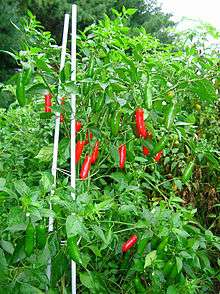 |
Serrano[15] | Serrano | Mexico | 10,000–23,000 SR | 5 cm (2.0 in) | The thin, tapered fruit turns red when mature. Due to its thin skin, it does not need to be peeled before use. | |
| Serrano Tampiqueño | Serrano | United States | 15,000–25,000 SR | 57 mm (2.25 in) | |||
| Sheepnose Pimento | Pimiento | United States | 0 SR | ||||
| Shishito | Japan | ||||||
| Sigaretta di Bergamo | Italy | 0 SR | |||||
| Siling Mahaba | Philippines | A chili pepper grown in the Philippines, and a popular ingredient in Filipino Cuisine | |||||
| Spanish Piquillo[15] | Spain | ||||||
| Sport Pepper | United States | 300–500 SR | 4 cm (1.6 in) | Superficially resembling both Tabasco and serrano peppers, the sport pepper is its own distinct cultivar[26][27] that is much milder than either of those. It is commonly pickled and used in Southern cooking and on Chicago-style hot dogs. | |||
| Super Chili[28] | 40,000–50,000 SR | Long and thin. Grows from green to red. | |||||
| Sweet Chocolate | 0 SR | ||||||
| Sweet Red Stuffing Pepper | Long Sweet | United States | 0 SR | 25–51 mm (1–2 in) | |||
| Sweet Yellow Stuffing Pepper | Long Sweet | United States | 0 SR | 25–51 mm (1–2 in) | |||
| Syrian Goat Horn | 180–200 mm (7–8 in) | ||||||
| Syrian Three Sided | Syria | 150–200 mm (6–8 in) | |||||
| Takanotsume[15] | |||||||
| Tangerine Dream | 76 mm (3 in) | ||||||
| Tam Jalapeño | Jalapneo | 1,000–1,500 SR | Similar to a jalapeño, but with significantly less heat. | ||||
| Tequila | 0 SR | Purple bell variety, not to be confused with the Tequila Sunrise, which is yellow. | |||||
| Tequila Sunrise Pepper | 1000–5000 SR | 150–170 mm (6–6.5 in) | Pastel orange in color. | ||||
| Tiburon Pepper | 2,000 SR | Hybrid improvement of the poblano pepper. Resistant to bacterial spot and tobacco mosaic virus. | |||||
| Topepo Rosso | 0 SR | ||||||
| Thai Yellow Chili | Small Hot | Golden yellow version of the Bird's Eye (Thai) chili. | |||||
| Tunisian Baklouti | Tunisia | ||||||
| Tien Tsin | China | 50,000–75,000 SR | Grown and used in China | ||||
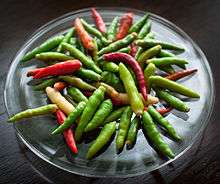 |
Thai Bird | Small Hot | Thailand | 3,000- 7,000 SR | Open-pollinated variety with long, thin erect fruit that mature to red. Used especially in thai dishes. Can be used fresh or dried. Exceptional flavor and spiciness. | ||
| Violet Sparkle | 0 SR | ||||||
| |
White Cloud | Blocky | United States | 0 SR | An heirloom ivory colored bell pepper when immature, that matures to red-orange. It has a sweet, mild flavor that bears fruit on an upright, compact plant. | ||
| White Lakes Pepper | Russia | 0 SR | |||||
| Yellow Monster | Blocky | 200 mm (8 in) | |||||
| Yolo Wonder | Blocky |
Capsicum baccatum
These have a distinctive, fruity flavor, and are commonly ground into colorful powders for use in cooking, each identified by its color.
| Image | Name | Origin | Heat | Pod Size | Description |
|---|---|---|---|---|---|
| Ají Amarillo | |||||
| Ají Brazilian Red Pumpkin | |||||
| Ají Criolla Sella | Bolivia | 30,000 - 40,000 SR | 51–76 mm (2–3 in) | Thin yellow fruits. | |
| Ají Crystal | Chile | 2.5–9 cm (0.98–3.54 in) | |||
| Ají Omnicolor[15] | 50,000 SR | This multi-colored plant produces orange, red, purple and ivory chilis. | |||
| Ají Pineapple | |||||
| Atomic Starfish | |||||
 |
Bishop's Crown | 10,000–30,000 SR | 6 cm (2.4 in) | C. baccatum strain from Barbados. Medium hot pods have a unique shape which resembles the hat of a Bishop. Sturdy plants, can be grown as perennials. Also known as bishops hat, orchid, ají flor, monks hat. | |
| Christmas Bell[15] | |||||
 |
Lemon Drop | 30,000–50,000 SR | 4 cm (1.6 in) | Very productive C. baccatum variety. Pods are thin walled and have a fruity taste with medium heat. | |
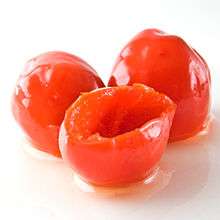 |
Piquanté | 1,000–2,000 SR | 2 cm (0.79 in) | Mild, sweet and tangy flavour, usable in many dishes |
Capsicum chinense
Capsicum chinense or "Chinese capsicum" is a misnomer since all Capsicum species originated in the New World. Nikolaus Joseph von Jacquin (1727–1817), a Dutch botanist, named the species in that way in 1776 because he believed they originated in China. Most of the peppers of this species have a distinctive flavor and are similar in flavor to each other.
| Image | Name | Origin | Heat | Pod Size | Description |
|---|---|---|---|---|---|
| 7 Pod Douglah | Trinidad | 923,000–1,853,396 SR | |||
| 7 Pot | Trinidad | 1,000,000 SR | |||
| 7 Pot Jonah | Trinidad | Turns from green to red as it ripens. | |||
| 7 Pot Jonah Yellow | Trinidad | Yellow color and a more fruity flavor than the normal 7 Pot Jonah. | |||
| 7 Pot Long | Longer and larger than normal seven pot peppers. | ||||
| 7 Pot Primo | Grows red. | ||||
| 7 Pot Primo Yellow | Australia | Grows yellow. | |||
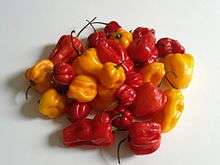 |
Adjuma | 100,000–500,000 SR | Very hot, originally cultivated in Suriname | ||
 |
Ají Dulce | 0–50 SR | |||
| Aribibi Gusano | Bolivia | 10,000 - 30,000 SR | 4–5 cm (1.6–2.0 in) | Small wrinkled pods, the colour turns from light green to ivory or pale yellow while ripening. Very fruity taste. Also known as Arivivi Gusano or Caterpillar Pepper. | |
| Bahamian Goat Pepper | Bahamas | ||||
 |
Bhut Jolokia[15] | Up to 1,500,000 SR | 6 cm (2.4 in) | This cultivar originated in Northeast India, and was once confirmed by Guinness World Records to be the hottest pepper. It is an interspecific hybrid, largely C. chinense with some C. frutescens genes. It is also known as naga jolokia and Ghost Pepper. | |
| Cachucha | |||||
| Cajamarca | |||||
 |
Caribbean Red[15] | Mexico | 445,000 SR | ||
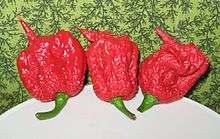 |
Carolina Reaper | United States | 1,569,300–2,200,000[29] SR | Extremely hot pepper, currently the Guinness book of world records holder as of August 7, 2013.[30] | |
| Chocolate Habanero | 300,000–425,000 SR | Brown variety of the classic Habanero, but much hotter. | |||
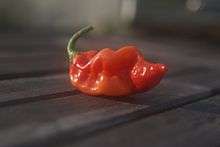 |
Datil[15] | 100,000–300,000 SR | A very hot chili; primarily grown in Florida | ||
| Devil's Tongue Red | 250,000–500,000 SR | ||||
| Devil's Tongue Yellow | United States | 125,000–325,000 SR | |||
| Dorset Naga | England | 1,000,000–1,500,000 SR | |||
 |
Fatalii | 125,000–325,000 SR | 6 cm (2.4 in) | Native to central and southern Africa, it is very similar in appearance to and often confused with the devil's tongue habanero. | |
 |
Habanero[15] | 100,000–350,000 SR | 5 cm (2.0 in) | Once considered to be the hottest chili pepper, the habanero has been surpassed by other hot varieties, but it is nonetheless hotter than most commonly available cultivars. The habanero has a subtle, fruity flavour and a floral aroma. It is closely related to many of the other very hot peppers, including the bhut jolokia from India, and the Scotch bonnet, Trinidad Scorpion Butch T, and Trinidad Moruga Scorpion peppers from the Caribbean. Disseminated to China over 500 years ago by Spanish and Portuguese explorers, it became so much a part of Chinese cuisine, botanists who found it in China thought it was native to the area and thus named this species Capsicum chinense, based on the habaneros from China. | |
 |
Hainan Yellow Lantern | 300,000 SR | 5 cm × 3.12 cm (1.97 in × 1.23 in) | Also known as the yellow emperor chili, it grows only in Hainan, China. | |
| Infinity chili | 1,176,182 SR[note 1] | ||||
| Lemon Yellow Habanero | |||||
 |
Madame Jeanette | 100,000–350,000 SR | Originally cultivated in Suriname | ||
| Mustard Habanero | United States | Habanero variety, the colour is mustard yellow. | |||
| Naga Morich | Bangladesh and India | 1,000,000 SR | |||
| Naga Viper | England | 1,382,118 SR[note 1] | |||
| NuMex Suave Orange[15] | United States | 800 SR | Very little heat, yet with a habanero taste. | ||
| NuMex Suave Red[15] | United States | 800 SR | Similar to a habanero in taste, yet with very little heat. | ||
| Peach Habanero | Peach coloured variety of the classic habanero. | ||||
| Red Savina | United States | 200,000–580,000 SR | |||
 |
Scotch Bonnet | 150,000–325,000 SR | 5 cm (2.0 in) | Named because of its resemblance to a Tam o' Shanter, this fruit is closely related to the habanero and is similarly hot. Due to its heat and distinct flavour, it is often used in Caribbean cuisine. | |
 |
Trinidad Moruga Scorpion[15] | Up to 2,000,000 SR | former World-record holder for hottest chili as of 2012 | ||
| Trinidad Scorpion[15] | |||||
 |
Trinidad Scorpion 'Butch T' | Up to 1,400,000 SR | Former world-record hottest chili. | ||
| White Habanero | 25–51 mm (1–2 in) | Also known as the Peruvian White Habanero Pepper. | |||
| Yucatán White Habanero | Mexico | 200,000–500,000 SR |
Capsicum pubescens
Capsicum pubescens is among the oldest of domesticated peppers, and was grown as long as 5000 years ago. It is probably related to undomesticated plants that still grow in South America (C. cardenasii, C. eximium, and others).
| Image | Name | Origin | Heat | Pod Size | Description |
|---|---|---|---|---|---|
| Canário | Peru | 30,000–50,000 SR | 6.5 cm (2.6 in) | Canário is a medium hot C. pubescens variety. Thick walled pods are dark yellow, when fully ripe and have the size of a small apple. This South American strain trives well under cool growing conditions and can be grown as a perennial. | |
| |
Rocoto | Peru, Bolivia | 30,000–100,000[32] SR | Also known as a Manzano pepper,[33] although there are a lot of other Rocoto varieties. Rocoto Manzano is only one of them. "Manzano" is the Spanish word for "apple", it describes the fruits' shape.
Sometimes Rocoto is known as "Locoto". |
Capsicum frutescens
Sometimes considered to be the same species as C. annuum
| Image | Name | Origin | Heat | Pod Size | Description |
|---|---|---|---|---|---|
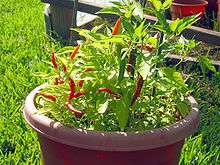 |
African Birdseye | 50,000–175,000 SR | 2.5 cm (0.98 in) | Also known as piri piri, it is common in Portuguese, Mozambican, and Angolan cuisines. | |
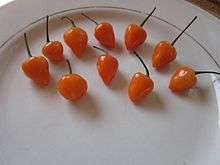 |
Kambuzi | Malawi | Kambuzi is a small, round chili pepper cultivar that is indigenous to the central region in Malawi, a landlocked country in southeast Africa. | ||
_2.jpg) |
Siling Labuyo | 80,000–100,000 SR | 2.5 cm (0.98 in) | A small, cone-shaped chili pepper cultivar native to the Philippines. | |
| |
Tabasco | 30,000–50,000 SR | 4 cm (1.6 in) | Used in Tabasco sauce. The fruit is only used when it is a particular red color measured with “le petit bâton rouge”.[34] |
See also
- Capsicum
- International Code of Nomenclature for Cultivated Plants
- USDA National Plant Germplasm System
- New Mexico State University: Chile Pepper Insititute
Notes
References
- ↑ "introducing the capsicum to the world". World Of Chillies. Retrieved 7 February 2015.
- ↑ USDA-ARS GRIN pepper seed collection, Experiment, Georgia
- ↑ Jarret, Robert L. "DNA Barcoding in a Crop Genebank: The Capsicum annuum Species Complex". The Open Biology Journal. 1 (1): 35–42. doi:10.2174/1874196700801010035.
- ↑ "The Plant List".
- 1 2 Redwood City Seed Company Catalog of Ecoseeds, Pepper descriptions. http://www.ecoseeds.com.
- 1 2 Dave DeWitt and Paul W. Bosland (2009). The Complete Chile Pepper Book: A Gardener's Guide to Choosing, Growing, Preserving, and Cooking. Timber Press. ISBN 978-0881929201.
- ↑ "Capsicum frutescens L.". Tropicos.org. Missouri Botanical Garden. Retrieved 19 Jul 2015.
- 1 2 "How are hybrid and open-pollinated vegetables different? | Oregon State University Extension Service | Gardening". extension.oregonstate.edu. Retrieved 2016-04-01.
- ↑ Jr, Alfred W. Crosby (2003-04-30). The Columbian Exchange: Biological and Cultural Consequences of 1492, 30th Anniversary Edition. ABC-CLIO. ISBN 9780313095399.
- ↑ "Pepper - Glossary - Cooking libraries - Cooking and recipes - Food & drink". Waitrose.com. Retrieved 2010-04-11.
- ↑ "Chilli - Glossary - Cooking libraries - Cooking and recipes - Food & drink". Waitrose.com. Retrieved 2010-04-11.
- ↑ Nations, Food and Agriculture Organization of the United (1990-01-01). Protected Cultivation in the Mediterranean Climate. Food & Agriculture Org. ISBN 9789251027196.
- 1 2 3 4 5 "Vegetable Varieties for Gardeners". Vegetable Varieties for Gardeners. Cornell University. Retrieved 21 May 2015.
- ↑ "Bird's Eye Chili Peppers". Chili Pepper Madness. Retrieved 7 February 2015.
- 1 2 3 4 5 6 7 8 9 10 11 12 13 14 15 16 17 18 19 20 21 22 23 24 25 26 27 28 29 30 31 32 33 34 35 36 "The Chile Pepper Institute Merchandise Catalog" (PDF). The Chile Pepper Institue. New Mexico State University. Retrieved 21 May 2015.
- ↑ "New Ornamental Pepper Wins Prestigious Award". The United States National Arboretum. Retrieved 5 February 2015.
- ↑ "Charleston Belle Pepper". Baker Creek Heirloom Seeds. Retrieved 6 February 2015.
- ↑ Gil-Jurado, A. T., Il senso del chile e del piccante: dalla traduzione culturale alla rappresentazione visiva in (G. Manetti, ed.), Semiofood: Communication and Culture of Meal, Centro Scientifico Editore, Torino, Italy, 2006:34–58
- 1 2 3 4 5 6 7 8 9 10 11 12 13 14 15 16 17 18 19 20 21 22 23 24 25 26 27 28 29 30 31 32 33 34 35 "The Chile Cultivars of New Mexico State University" (PDF). The Chile Pepper Institute. New Mexico State University. Retrieved 21 May 2015.
- ↑ "Mirasol Chili Peppers". Chili Pepper Madness. Retrieved 5 February 2015.
- ↑ Jean Andrews (2005). The Peppers Cookbook: 200 Recipes from the Pepper Lady's Kitchen. University of North Texas Press. p. 14. ISBN 9781574411935.
- ↑ http://newscenter.nmsu.edu/Articles/view/9970/nmsus-chile-pepper-institute-goes-from-red-to-green-with-latest-variety-numex
- ↑ "The Scoville Heat Measurement Chart". Wiw.org. Retrieved 2012-02-29.
- ↑ "Selective Enzyme-Mediated Extraction of Capsaicinoids and Carotenoids from Chili Guajillo Puya (Capsicum annuum L.) Using Ethanol as Solvent". Oocities.org. Retrieved 2012-02-29.
- ↑ "Salsa Garden cubit: Salsa Garden Pepper Database: Puya, Capsicum annuum (Hot Pepper)". Cubits.org. 2010-05-12. Retrieved 2012-02-29.
- ↑ "What Are Sport Peppers?". Fireyfoods.com. Retrieved 2013-08-12.
- ↑ "SPORT". Tomato Growers Supply Company. Retrieved 2013-08-12.
- ↑ "Super Chili Chili Peppers". Chili Pepper Madness. Retrieved 7 February 2015.
- ↑ Hallock, Betty. "World's hottest pepper hits 2.2 million Scoville heat units". Los Angeles Times. Los Angeles Times. Retrieved 11 July 2014.
- ↑ "Hottest chili". Guinness World Records. Retrieved 11 July 2014.
- ↑ Paul Adams (7 July 2011). "FYI: What is the Hottest Pepper in the World?". Popular Science. Retrieved 12 October 2016.
- ↑ "Which Chile Peppers are Which?". About Travel. Retrieved 5 February 2015.
- ↑ "Rocoto Chili Peppers". Chile Pepper Madness. Retrieved 7 February 2015.
- ↑ "How We Make Original Red Sauce | TABASCO® Products | TABASCO.com". TABASCO.com. Retrieved 2016-04-01.
Further reading
- G6CSY chile database: Used as source for information on various cultivars in this article.
- chillisgalore database: More can be found here.
- NMSU Chile Pepper Institute list of chile cultivars